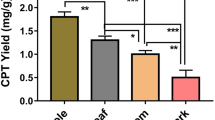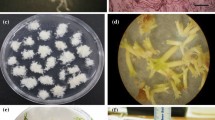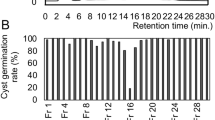Abstract
CAMPHOR has been reported by Bauch1 to be effective in inducing polyploidy in fungi. Thaysen and Morris2 succeeded in producing a giant strain of Torulopsis utilis by treatment with camphor vapour. It was therefore determined to test the effect of camphor vapour on Penicillium notatum strain N. R. R. L. 1978 B. The procedure was to add different, amounts of camphor to flasks each containing 25 ml. of sterilized 3 percent malt agar. The agar was then poured into Petri dishes of 100 mm. diameter. The cultures on the plates to which 75 mgm. of camphor had been added showed a distorted growth. Conidial formation was delayed but after twenty-two days some spores were formed. When these were examined microscopically, some of the spores were found to be larger than the others, whereas spores from control cultures were uniform in size. Spores from the treated and control cultures were plated out on malt agar by the dilution method. There were no macroscopic differences between the colonies from the control and treated samples. When examined for spore size, however, thirty colonies from the control series were found to have spores of the same size, whereas, out- of forty-four colonies from the treated samples, thirty-five were like the controls, five had spores larger than the controls and four had a mixture of large and average sized spores. Isolations were made from these large-spored colonies and 'gigas' lines established. Fig. a shows spores from a normal line and Fig. b spores from a gigas line, three months after isolation and after being subcultured four times. The change thus appears to be permanent. Camphor treatment has been shown to induce polyploidy in higher plants3, and since pollen grain size has been found to be a useful criterion of polyploidy, it is probable that the 'gigas' forms with larger spores in Penicillium are polyploids.
This is a preview of subscription content, access via your institution
Access options
Subscribe to this journal
Receive 51 print issues and online access
$199.00 per year
only $3.90 per issue
Buy this article
- Purchase on Springer Link
- Instant access to full article PDF
Prices may be subject to local taxes which are calculated during checkout
Similar content being viewed by others
References
Bauch, R., Naturwiss., 29, 503 (1941).
Thaysen, A. C., and Muriel Morris, Nature, 152, 526 (1943).
Levan, Albert, and Gunnar Ostergren, Hereditas, 29, 381 (1943).
Author information
Authors and Affiliations
Rights and permissions
About this article
Cite this article
SANSOME, E. Induction of 'Gigas' Forms of Penicillium Notatum by Treatment with Camphor Vapour. Nature 157, 843–844 (1946). https://doi.org/10.1038/157843b0
Issue Date:
DOI: https://doi.org/10.1038/157843b0
This article is cited by
-
Versuche zur Genomverdoppelung des AscomycetenPodospora anserina (CES.) Rehm
Zeitschrift für Vererbungslehre (1962)
-
Production of heterozygous diploids in filamentous fungi
Experientia (1952)
-
Some mycological aspects of penicillin production
The Botanical Review (1950)
-
Problems in microbial genetics
Heredity (1948)
Comments
By submitting a comment you agree to abide by our Terms and Community Guidelines. If you find something abusive or that does not comply with our terms or guidelines please flag it as inappropriate.



